Crypto Portfolio Allocation: How to Diversify Like a Pro

Crypto investing doesn’t have to be a gamble. In this article, we’ll walk you through the essentials of crypto portfolio allocation, the strategy behind diversifying your assets to minimize risk and maximize potential. We’ll explore how different cryptocurrencies correlate, how to align your investments with your goals, and why a well-balanced portfolio can outperform. Whether you're just starting or looking to refine your strategy, this guide will give you the tools to manage your crypto investments like a seasoned pro.
- An Overview of Portfolio Allocation & Cryptocurrency Correlation
- Determine Your Investment Goals
- Crypto Portfolio Allocation Best Practices
- Cryptocurrencies With Different Use Cases
- Dollar-cost Averaging and Buying the Dips
- Diversification Beyond Cryptocurrency
- Maintaining and Rebalancing Your Crypto Portfolio
An Overview of Portfolio Allocation in Cryptocurrency
The key to smart investing is diversification – spreading your investments across different assets to reduce overall risk. Ray Dalio, a renowned investor, calls it the “Holy Grail of Investing.” However, many people get it wrong by thinking that different assets within the same class are enough to protect their investments.
That's where portfolio allocation in non-correlated assets comes in – it might be the ace up your sleeve in investing. By owning a mix of assets with little to no relationship, you reduce the impact of any one investment's performance on your overall portfolio. Your expected returns remain afloat even if the stock market takes a dive. As you can see from the chart below, taken from the book “Principles,” diversifying your portfolio is crucial for maximizing returns and minimizing risk.
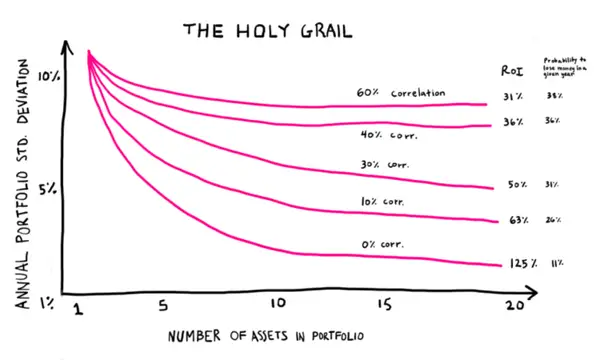
So, what about cryptocurrencies? Are cryptocurrencies a good addition to diversify your portfolio? We know how traditional assets correlate with each other, but how does cryptocurrency correlate with traditional assets?
Establishing a statistical relationship between cryptocurrencies and other assets in the economy is easier said than done. Cryptocurrencies are a new breed of asset, and we don't have enough data to see how they will behave over the long arc of time. Adding to the confusion, some cryptocurrencies lack a clear use case, making it tough for investors to understand them from a fundamental point of view.
“DOGE, a coin that was created as a joke, has had no active development for years. It's a humour fork of Bitcoin offering no technical innovation.”
Willy Woo
Moreover, at times cryptocurrency prices are inversely correlated to stock prices. But during the COVID-19 pandemic and the 2020 U.S. presidential election, Bitcoin and the S&P 500 showed a strong correlation.
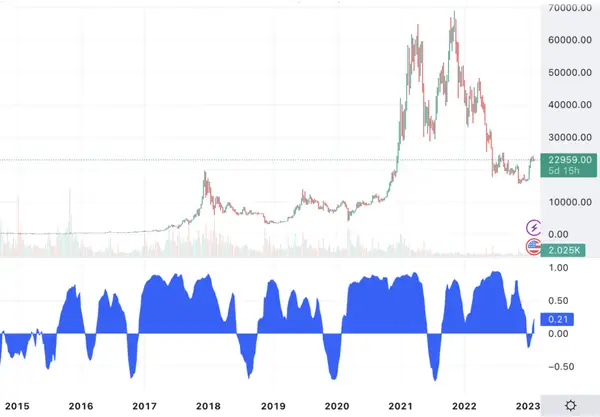
As we can see, the first analysis does not give us the insight we hoped for. Also, relying on the news is not the smartest thing to do regarding cryptocurrencies because, according to bad reporting, “Bitcoin has died many times.” Or as John Kenneth Galbraith once said: “The only function of economic forecasting is to make astrology look respectable.”
Thus we will give you plain data on cryptocurrency correlation so you can make a thoughtful decision for your portfolio allocation. Luckily, the CFA Institute has analyzed the correlation of Cryptocurrencies to different asset classes. From Cryptocurrencies to ETF sectors, Commodities, Mutual Funds, and Passive and Active Equity and Bonds.
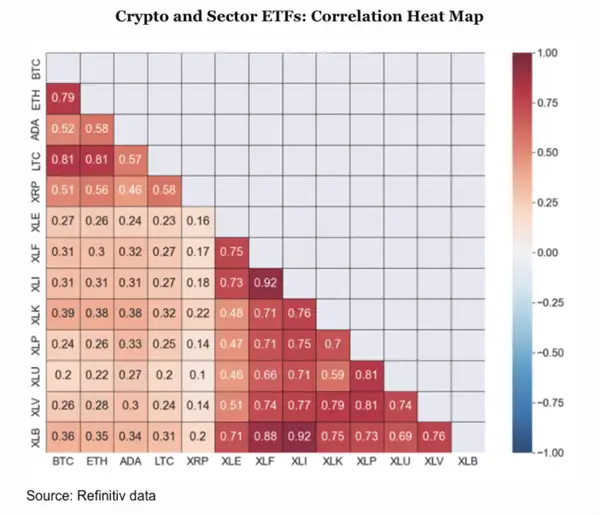


The main takeaway is that cryptocurrencies are generally weakly correlated and don't move in the same way as other investments, like commodities, mutual funds, or specific ETFs. However, with time this might change, and you should always look for the most up-to-date correlations.
Nevertheless, as of now, cryptocurrencies are a weakly correlated asset that might help diversify your portfolio. So, next, we will determine your investment goals, explore the best practices for crypto portfolio allocation, and show you how to maintain and rebalance your crypto portfolio to maximize your returns. So buckle up, and let's dive into the depths of crypto portfolio allocation!
Determine Your Investment Goals
Short-term vs. Long-term Investment
Short-term and long-term investors differ in their investment horizons and strategies. Short-term investors tend to focus on financial instruments with high volatility and liquidity, such as short-term bonds or currencies, to profit from price movements within a brief period.
On the other hand, long-term investors seek assets with slower, more predictable growth, such as real estate, mutual funds, and bonds, and aim to hold these assets for several years. Obviously, all assets can be held short and long-term; however, the more illiquid the asset, the more likely it is to be held for the long term.
Similarly to stocks, cryptocurrency can also be traded short-term or long-term. Interestingly, even though Bitcoin has rather high volatility, making it a great asset to trade short-term, most investors hold it for the long-term, as you can see from the HODL Waves Chart.
Ultimately, there is no right or wrong answer between becoming a long-term or short-term investor. Maybe it is a mix for you. Anyway, the choice is yours, but it is worth noting that long-term investors might sleep better at night and not be rattled by scary headlines and breathless commentary.
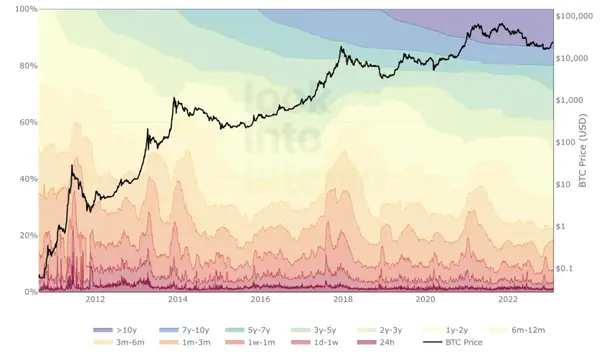
Investment Size
When it comes to portfolio allocation, investment size is key. But what are some good rules of thumb on investment size? One strategy to consider is billionaire investor Ray Dalio's “All Weather portfolio,” which allocates investments across several asset classes, including long-term bonds (40%), stocks (30%), commodities (7.5%), gold (7.5%), and intermediate-term bonds (15%). However, this portfolio doesn't consider cryptocurrencies or other illiquid assets, which may also be a valuable addition to a diversified portfolio.
Also, how does Cryptocurrency affect your portfolio? To answer that, we might again refer to a study by the CFA Institute. According to that study, cryptocurrencies such as Bitcoin can provide improved returns and increased stability in a portfolio.
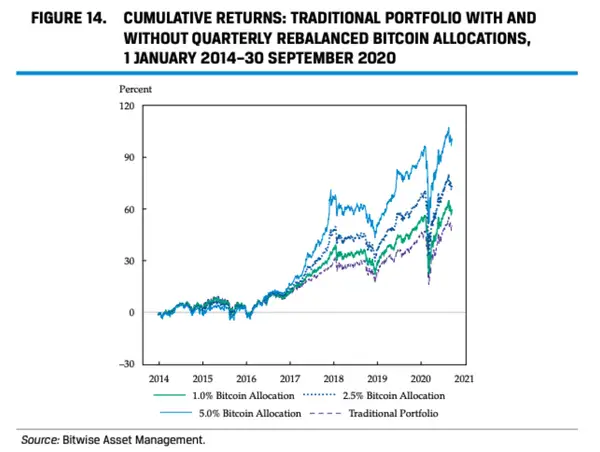
The study found that a quarterly rebalanced 2.5% allocation to Bitcoin over a six-year period from 2014 to 2020 improved returns by 23.9 percentage points. Furthermore, the study suggests that increasing the allocation to Bitcoin led to higher average returns and higher average Sharpe ratios. For example, a 1% allocation to Bitcoin added 5.3% to the portfolio's return and boosted the Sharpe ratio by 0.19, whereas a 5% allocation to Bitcoin added 28.1% to the portfolio's return and boosted the Sharpe ratio by 0.69, on average.
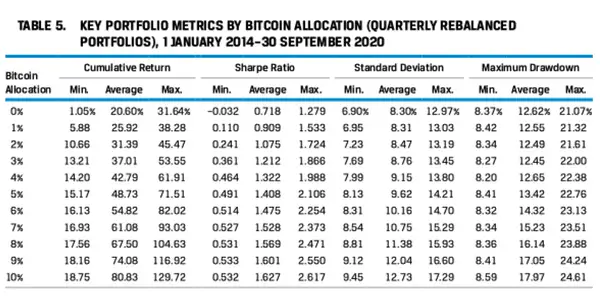
So, incorporating cryptocurrencies as a diversification asset, with an investment size similar to commodities or gold, might be a good strategy. However, before making a final decision, you should consider your risk tolerance. So, read the next paragraph on risk tolerance, as both concepts are closely related to your portfolio allocation strategy.
Risk Tolerance
The final factor for investment sizing and portfolio allocation, in general, is risk tolerance. As we previously noted in our article “Trading Without Leverage,” minimizing losses should be a top priority for investors. The importance of this principle is evident in the fact that it takes a return of 1900% to recover from a 95% loss.
Regarding cryptocurrency investments, the CFA Institute conducted a study that found that having between 0% and 4% of a portfolio invested in Bitcoin does not significantly impact the maximum drawdown. However, if an investor chooses to allocate more than 4% to Bitcoin, the maximum drawdown could increase significantly, thereby increasing the risk of losing money. So, if you are rather risk-sensitive, you might limit the investments in Bitcoin to less than 4%.
Let us say there are three different risk profiles for investors: Cautious, Balanced, and Adventurous. Each profile can adjust its risk tolerance according to its investment goals and strategies. For instance, a short-term investor may opt to lend out their coins and earn a fixed return through stablecoin lending or staking. On the other hand, an adventurous investor may invest more in new and high-risk cryptocurrencies.

Fixed returns versus potential returns in a portfolio can also be adjusted based on risk tolerance. A cautious investor would prioritize stable returns and aim for a lower maximum drawdown, whereas an adventurous investor may invest more heavily in higher-risk opportunities. According to our subjective analysis and experience, the maximum drawdown for a cautious investor can be around 20% or less, while an adventurous investor may face a maximum drawdown of 85%. The diagram above should always serve as a quick visualization and reminder. From left (cautious) to the right (adventurous), the more potential returns an investor seeks, the higher the risk of losing their portfolio.
Note: If you’re unfamiliar with stablecoins, you should look at this overview created by Messari. You can use protocols like Compound or Aave to lend out your stablecoins.

Crypto Portfolio Allocation Best Practices
Overview of Strategies
Before diving deep into crypto portfolio allocation strategies, you shall comprehensively understand the industry. One study conducted by L1 Digital offers an insightful sector mapping of the cryptocurrency market.
Coindesk also provides an alternative perspective on the market. Even for us, it was surprising to see that sectors such as DeFi, Culture & Entertainment, and Computing account for just 5% of the market capitalization of the DACS Sectors. Did you know that?
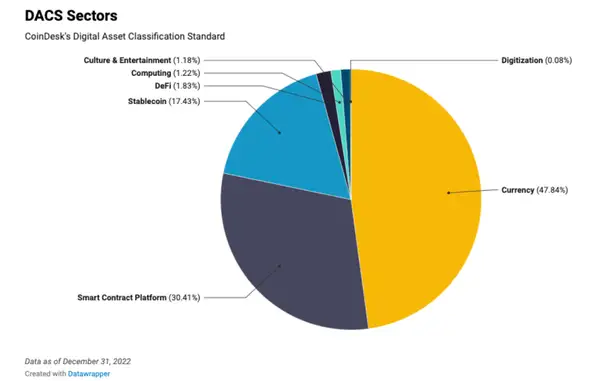
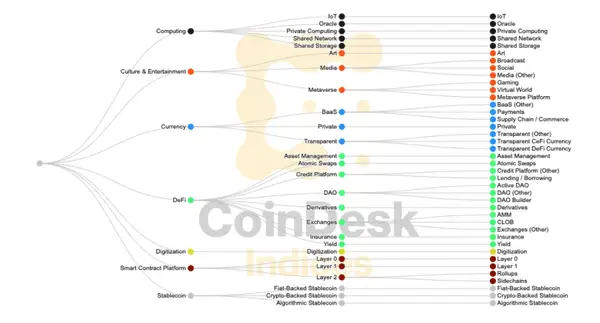
Once you are familiar with the landscape, we can dive deeper into various allocation best practices. This is definitely not an exhaustive list of strategies. Rather, these strategies can serve as a starting point for further research. Also, as stated above, these strategies can be paired with stablecoin lending or staking to match your desired level of risk tolerance. Overall, we have prepared four starter strategies for you:
- There is no second best
- Crypto Money
- Fifty Fifty
- The Deep Dive
1. There is no second best

The first strategy is simple. Michael Saylor took this strategy so seriously with Microstrategy that it became a Meme. However, often the most simple strategy is the best one. In the end, Bitcoin is the first cryptocurrency, the most dominant one, is held by corporations, is a legal tender of governments, and might provide many interesting use cases.
2. Crypto Money
Next up is the crypto money portfolio. The Bankless community created this portfolio allocation strategy, as the two most dominant cryptocurrencies represent reserve money potential. Hence, only “Sound money” BTC and “Ultrasound money” ETH should be allocated to your portfolio.
Follow up on the meme in the first strategy: Someone created a comparison tracker to mock Michael Saylor because his Bitcoin maximalist thesis would be more profitable if he invested in ETH.
3. Fifty Fifty
More adventurous investors go for a Half/Half strategy. This strategy invests 50% in altcoins while investing the other 50% according to one of the strategies above (BTC only or BTC & ETH). The idea behind that is that you have an amazing asymmetric investment opportunity. You risk a small amount in return for a chance to get massive gains. For example, Vitalik Buterin, the founder of Ethereum, has turned $25K into $4.3M in the course of 3 years by buying Dogecoin.
However, be aware that most of the altcoins might fail. Willy Woo did a great analysis, showing that there are only two types of altcoins, and most are not good investment decisions.
4. The Deep Dive
You may want to consider the “Deep Dive” allocation strategy to diversify your portfolio within the cryptocurrency industry and beyond. This approach involves allocating investments across various virtual assets with diverse use cases, taking advantage of fractional trading options to invest in markets such as NFT Art. The strategy offers the potential for greater diversification and exposure to unique investment opportunities within the ever-expanding world of cryptocurrencies. To fully understand the “Deep Dive” strategy, we will dive deep into the different sectors and use cases of the cryptocurrency industry in the next section.
Cryptocurrencies With Different Use Cases
Let’s start with the deep dive. According to CoinDesk and L1 Digital's mapping of the industry, there are broadly six main sectors: DeFi Sector, Currency Sector, Smart Contract Platform Sector, Computing Sector, Digitization Sector, and Culture & Entertainment Sector. While a comprehensive examination of each sector is beyond the scope of this article, it is worth noting that the possibilities for diversification within the cryptocurrency market are vast.
You can follow each link to get more information and inspiration about each sector. However, we will also provide you with the latest trends in areas that might not be covered extensively. These include upcoming areas, such as decentralized social networks, decentralized physical infrastructure, and web3 gaming, all of which are covered in depth by market analytics firm Messari. The report includes more information and trend overviews on Ethereum Rollups, New Layer 1s, and DeFi. We suggest reading it.



You can copy existing portfolios and indices if you are not an avid reader. For example, Index Coop provides more standardized indices, similar to Coindesk, with more or less sound projects. Enzyme, on the other hand, provides different indices and portfolios created by individuals worldwide, so you might also find very risky and unique coins there.
It is important to note that while indices such as the DeFi Pulse Index from Index Coop can provide useful information and inspiration for portfolio creation, buying the index coin itself is not always recommended. Instead, investors may want to use these indices as research tools and build their own portfolios using individual coins purchased on different platforms, offering greater flexibility and control over their investments. Nevertheless, as you will quickly see, most of the portfolios hold similar cryptocurrencies. Here is an example of the DeFi Pulse Index from Index Coop and a Defiable Mid/Small Caps Portfolio.

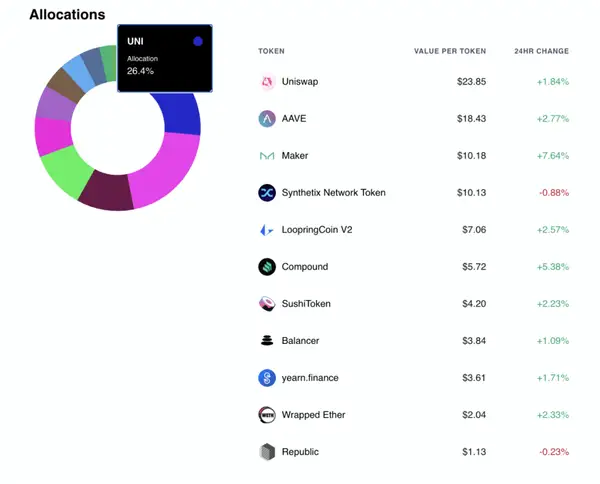
If you want to explore even beyond indices, we suggest going to the portfolio allocations of big funds directly. As holdings are often transparent and tracked by on-chain platforms, you can copy the biggest players like Grayscale, Polychain Ventures, Dragonfly Capital, Pantera Capital, a16z, Coinbase Ventures, Binance Labs, or smaller companies like Messari.
Unfortunately, even after a thorough examination of the cryptocurrency landscape, and despite having diverse use cases, the sector as a whole is still highly correlated. The reason might be that the different sectors are too small to be a standalone market. Moreover, most sectors are rather new, and there might not be enough data to provide real information on correlation. As a result, portfolio allocation within the cryptocurrency industry can be a challenge for investors. Nevertheless, we created a correlation matrix to see how the sectors within are correlated. Ultimately, we will see how the correlation matrix will evolve with time. Until then, investors should do the necessary due diligence on cryptocurrencies to position themselves for profits in times of less correlation.
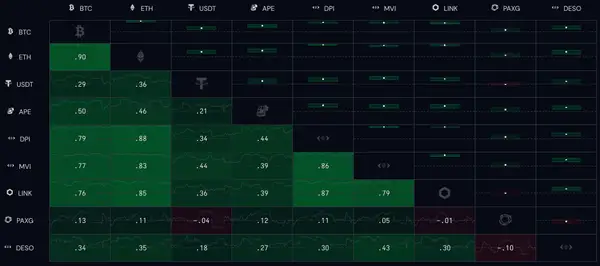
Allocation Based on Fundamental Analysis
This section will help you as a starting point for the necessary due diligence. Cryptocurrencies are not Stocks, and different principles of analysis apply. Especially if you do not feel comfortable investing in narrative alone, this section might be for you. If you're unsure when to invest, it's crucial to look at key metrics. For a comprehensive analysis, you can refer to Galaxy Digital's research report.
To find the information for your analysis, you will not go to company reports anymore but rather to blockchain explorers, such as Blockchair or Etherscan. These explorers give you the real-time transaction history of a single coin. However, the data available on these sites is limited, so it's advisable to use providers like Coin Metrics and Glassnode for more in-depth analysis and comparison with other chains. When analyzing cryptocurrencies, there are three main metrics: Issuance, Transfer and Transaction, and Supply Metrics.
Issuance Metrics
Issuance Metrics help to understand the growth rate of the crypto asset, if it is scarce, and identify the inflation or deflationary trends of the coin.
Issuance Metrics provide insight into the supply of a given crypto asset. You can understand the asset's potential for appreciation or depreciation by analyzing these metrics. This will help you to understand the growth rate, scarcity, and inflation or deflationary trends of a cryptocurrency.
Transfer and Transaction
Transfer and Transaction metrics are useful to understand a coin's usage, especially users' real economic activity. However, it's important to note that the volume of transactions can vary depending on the method used, as not all transactions represent genuine economic activity. By carefully analyzing Transfer and Transaction Metrics, investors can understand a cryptocurrency's potential for growth and adoption.
Supply Metrics
Supply Metrics are mostly used for identifying the long-term and short-term holders of assets. Moreover, you can see who holds the asset by using blockchain heuristics to label blockchain addresses. The supply Metrics are often coupled with the metrics above to create more complex valuation models.
Combinations of Primary Metrics
Investors can utilize secondary metrics, which are composed of primary metrics, to gain a better understanding of the market value of Bitcoin. These metrics offer insights into the overall state of the cryptocurrency industry, with Bitcoin being the primary asset. However, it's important to note that not all cryptocurrencies can be analyzed with these metrics and that they are not designed to determine the inherent value of an asset. Instead, they serve as useful markers for market highs and lows and provide another tool in an investor's arsenal of portfolio allocation strategies.
Bitcoin Days Destroyed: Sharp changes in BDD indicate that dormant coins are a transaction, which might indicate long-term holder selling.
Network Value to Transactions: It is often a lagging indicator of market bubbles and highs, showing that the market value of a coin is high relative to the coin's network utility. It is especially high during bullish market sentiment.
Market Value to Realized Value: If MV is higher than RV, it indicates that, on average, investors are holding the coin at a profit. If the MVRV was below 1, it was usually a great buying opportunity in the past. Or, as Ryan Selkis wrote: “Sell-a-kidney-to-buy-more territory.”
Difficulty Ribbons: When the difficulty ribbon compresses and indicates miner capitulation, it might suggest a low sell pressure and room for bullish price action in the market. This metric only works for Bitcoin, as it is based on proof-of-work. There are alternative metrics for other proof-of-stake blockchains, such as the number of active validators or percentage of supply staked.
Other Metrics: There are tons of metrics out there. As we said, you can always use the sites we recommended to view more complex metrics. If you want even more, check out Woobull, LookIntoBitcoin, or BlockchainCenter.
Dollar-cost Averaging and Buying the Dips
“The only problem with market timing is getting the timing right.”
Peter Lynch
If you are unsure when to buy, you might want to look into dollar cost averaging. Dollar-cost averaging might be the most reliable strategy, minimizing drawdown and still getting good profits in the long run. This strategy is probably the most straightforward, apart from “buy and hold.” Variations of it are often replicated by retail and professional investors.

Diversification Beyond Cryptocurrency
This section is the last portfolio allocation section and goes beyond classic cryptocurrency. As crypto allows for trading and investing in virtual copies of real assets, the possibilities are almost endless. This is one of the main reasons why some believe that the blockchain will revolutionize financial markets and lead us into a new era of the internet of wealth. So, blockchain will allow you to diversify your portfolio even further without traditional constraints like liquidity or counterparties.
NFTs
Art has been a valuable investment for centuries, often outperforming traditional investments, especially during inflation. In recent years, a new sector within the multi-trillion-dollar art market has emerged: Non-Fungible Tokens (NFTs). According to NFT Valuations, the current value of the NFT market is around $12 billion, representing less than 1% of the overall physical art market. Despite declining towards the end of 2022, there is still significant growth potential for NFTs as more people understand their value.
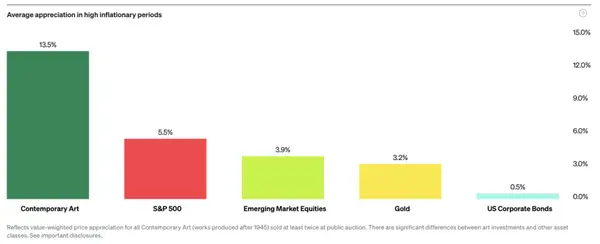
Thanks to the innovation of blockchain technology and fractional trading, investing in high-value art collections, like CryptoPunks and Bored Apes, is now accessible to a wider range of people. In the past, investing in art required millions of dollars in capital. Today, with as little as $1, anyone can become a part of this exciting new investment opportunity.

As NFTs continue to gain recognition and popularity, they provide a unique opportunity for diversification beyond traditional cryptocurrency investments. By investing in NFTs, investors can take advantage of the art market's growth potential while reducing their overall portfolio risk.
Unique Markets
However, it does not stop with NFTs. The horizon is much, much bigger. Investors are no longer limited to traditional stocks and bonds for diversifying their portfolios. The rise of blockchain technology has opened up new avenues for investment in unique markets. With the ability to turn anything with a reliable data feed into a market, investors can trade a wider range of assets, such as wine, Rolex watches, rare sneakers, real estate, and many more. Morpher is making it possible to trade these previously illiquid assets without a counterparty, giving investors more opportunities for diversification and potentially higher returns. The horizon is vast, and soon investors will be able to trade all assets versus all assets, creating a truly all-weather diversified portfolio. With the help of blockchain and virtual copies of assets, the possibilities for investment in unique markets are endless.
Maintaining and Rebalancing Your Crypto Portfolio
Finally, you almost made it to the end. The last section is about maintaining and rebalancing your crypto portfolio. Rebalancing a portfolio is a well-established technique that finance professionals have been using for decades. It's a straightforward concept that ensures that each asset in your portfolio holds a specific share of its combined value. The goal of rebalancing is to limit exposure to risk by selling underperforming assets and reinvesting in high performers.
One of the key advantages of rebalancing is that it promotes diversification. Diversification reduces risk by allowing you to compensate for any losses incurred from a single asset. Regular rebalancing prevents you from becoming too emotionally attached to a particular cryptocurrency and ensures that your portfolio aligns with your investment goals.
There are different strategies you might use for rebalancing. However, for some investors rebalancing is not the right thing to do, as they fear missing out on potential gains. There is a famous saying on Wall Street stating exactly that.
“Cut your losses short and let your winners run.”
In conclusion, approach rebalancing with common sense. Reassess your rebalancing strategies from time to time, and if you hold assets that will potentially collapse, cut them short.
PS: do not forget the tax implications.
Conclusion
In conclusion, you were given a glimpse into the strategies, assessments, ideas, and best practices of crypto portfolio allocation. But let us not forget the most important thing: reassessing your investment goals. Don't be a prisoner to investment maxims and formulas, for they will only take you so far. Forge your own thesis, roll the dice, and be ready to adjust when the winds of change come blowing in. The crypto market is volatile, and only the nimble and cunning will survive.
“Conviction is not blind faith.”

Disclaimer: All investments involve risk, and the past performance of a security, industry, sector, market, financial product, trading strategy, or individual’s trading does not guarantee future results or returns. Investors are fully responsible for any investment decisions they make. Such decisions should be based solely on an evaluation of their financial circumstances, investment objectives, risk tolerance, and liquidity needs. This post does not constitute investment advice.

Painless trading for everyone
Hundreds of markets all in one place - Apple, Bitcoin, Gold, Watches, NFTs, Sneakers and so much more.

Painless trading for everyone
Hundreds of markets all in one place - Apple, Bitcoin, Gold, Watches, NFTs, Sneakers and so much more.









